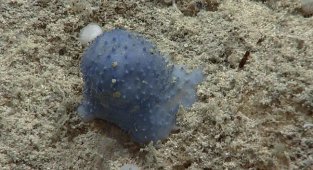15 amazing living creatures that were recently discovered (16 photos)
Every year, scientific researchers discover new species of insects and animals that can surprise with their unusual appearance. In the collection you can see a small list of creatures that look like they are from another world. 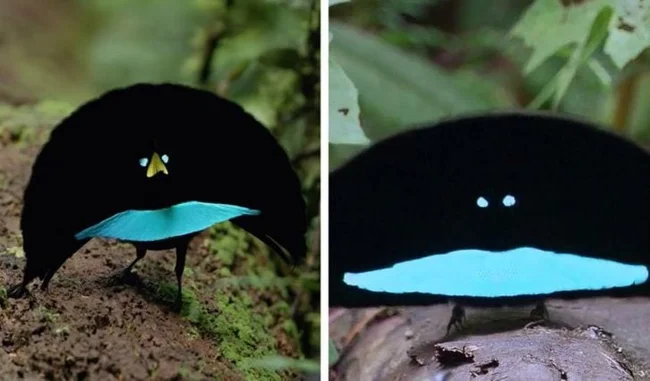
Have you ever asked yourself how many species of animals are there on earth? Scientists say about 8.7 million. Wow! This is an incredible amount. But just think - only 14% of this number were studied. Humans may have explored most of the planet, but about 86% of creatures are still waiting to be discovered. Who would have imagined that many unknown species live in the depths of the Mariana Trench, in the thickets of the Amazon forests or in the deepest and darkest caves? And many of them look completely alien.
Fish Mola Tecta 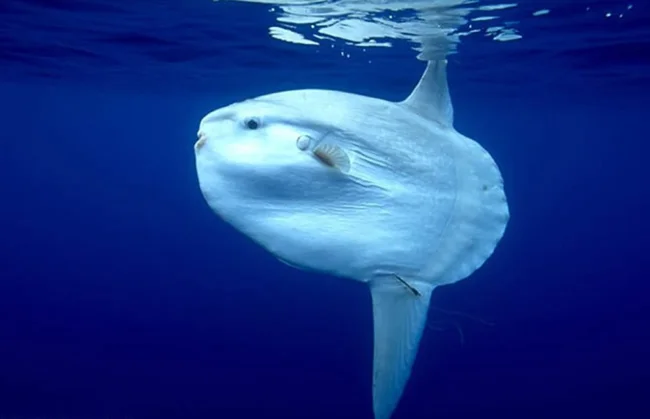
The Mola Tecta fish was discovered by Marianne Nygaard and her colleagues in 2017. For a fish that is believed by researchers to live solitary lives, it is a fairly large creature. Also known as the giant sunfish, Mola Tecta weighs two tons and can reach 4.5 meters in length. The fish lives in cool, deep waters near New Zealand, Australia and southern Chile. The discovery of this sunfish, nicknamed Hoodwinker (which means “swindler” in English), perfectly shows how a huge creature can remain out of sight of scientists for a long time, despite its amazing and alien appearance.
Lasiognathus Dinema 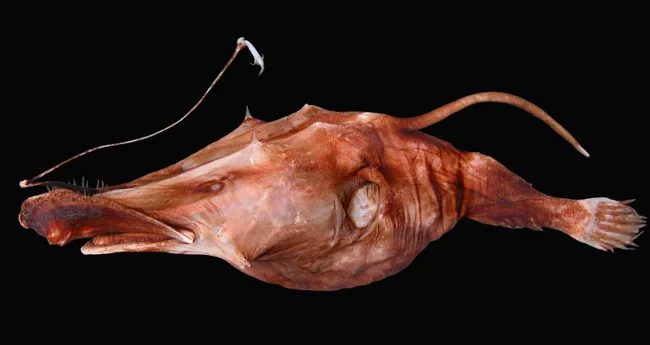
A similar story happened with Lasiognathus Dinema. This unusual creature is much smaller in size than Mola Tecta, and was discovered only in 2015. It is often found in the northern Gulf of Mexico and looks like an abstraction of a fish with a long “rod” on top. Researchers found Lasiognathus Dinema at a depth of 1,500 meters underwater. The largest of them was 95 millimeters long. Outwardly, this fish is not as scary as Mola Tecta, but looking at it, you can once again appreciate the diversity of creatures living in the depths of the ocean.
Pseudoliparis swirei 
Speaking of the depths of the ocean. In 2017, Mackenzie Gerringer and his colleagues discovered a fish living in the deepest ocean trench. The Mariana sea slug was captured using a camera trap located at a depth of 8 km, where the pressure is 1000 times greater than on the surface. Mariana slugs are bright pink and not particularly pretty to look at, but they are currently the only fish we know of that live this deep underwater.
Eriovixia gryffindori 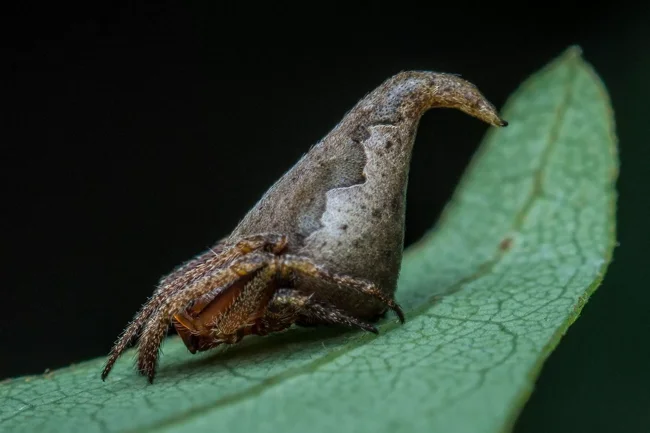
Let's take a break from the ocean and return to land to meet an extraordinary insect. Researchers and brilliant biologists Javed Ahmed and Raja Rashid Halabi, being fans of the Harry Potter films, gave it the name Eriovicia gryffindori. In 2016, the two were exploring biodiversity in the Western Ghats and found a spider that looked like an ancient witch's hat. The spider's body is 7 millimeters long and has a brown color for camouflage from predators. With just one look at the alien's hat-like back, Javed and Raja decided that their love of Harry Potter had finally been put to work.
Wonderful bird of paradise 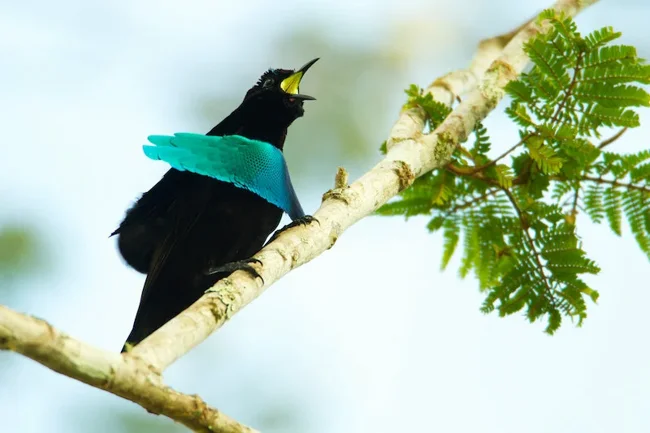
There are more than just weird spiders in the jungle. In 2018, Edwin Scholes and Timothy Laman discovered a new species of the famous bird of paradise in the West Papua province of Indonesia. The best-studied species of these birds are famous throughout the Internet for their smiley-face-like coloration and energetic mating dance. However, the species discovered by Scholes and Laman shows different courtship signals and is different in appearance: the “smiley face” is located upside down. In fact, this is already a grin. Birds of this species would rather circle potential mates during courtship than jump. They may not be aliens, but this beloved species illustrates the wonders of genetic mutation on our planet.
Blue tarantula 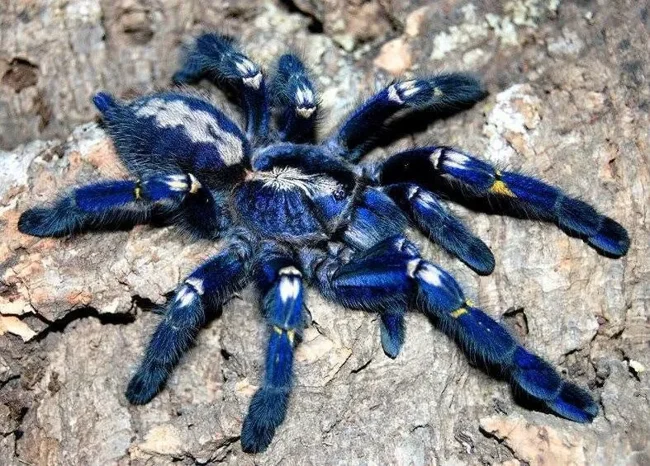
There are many strange spiders in the world. The blue tarantula, thanks to its unusual coloration, made headlines in 2017 when it was discovered in Guyana's Kaieteur National Park. University officials in Akron, Ohio, believe it may be one of the 40 species of blue tarantulas in the world. But debate about the reasons for such an unusual color still does not subside. At least during daylight hours, this coloring makes the tarantula easily visible.
Medusa-UFO 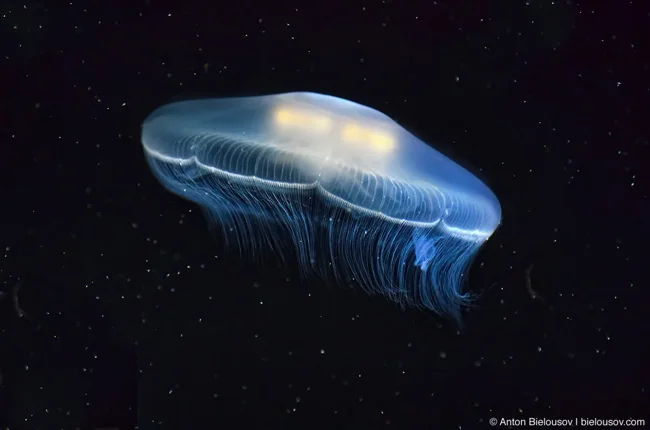
Let's go back underwater, where another creature lives that has become an Internet sensation. It was discovered in 2017 by a team of marine biologists from the US National Oceanic and Atmospheric Administration. Rhopalonematid trachymedusa is a new species of deep sea jellyfish affectionately named the UFO Jellyfish. This underwater alien has two rows of tentacles: one row points up, the other points down. The study of this jellyfish is still ongoing, but its unusual structure fascinates both ordinary people and scientists.
Etmopterus Lailae 
It's not just UFOs that happen underwater. Creatures living deep in the ocean exhibit bioluminescence. A recently confirmed new species of shark has attracted media attention with its glow-in-the-dark nose. Discovered in 2000 by Stephen Kajiura, this shark was only recently given the name Etmopterus Lailae. Weighing up to a kilogram and 30 cm long, it lives near the Northwestern Hawaiian Islands. The delay in classifying the shark as a new species was due to the need to compare the species with other lightning sharks around the world. Now, finally, Etmopterus Lailae can be considered an independent species and perceived as a unique underwater alien.
Neopalpa donaldtrumpi 
But not all names are given with love. For example, as is the case with a butterfly from the moth family discovered in 2017. The distinct blond hair on the moth's head prompted Vasric Nazari of the University of California to dub the creature Neopalpa Donaldtrumpi. Nazari says that by naming the moth after the 45th President of the United States, he is drawing political and public attention to the need to preserve the moth's fragile habitat throughout the state of California. It's a more subtle attempt to raise awareness of climate change than that undertaken by British company EnviroBuild co-founder Aidan Bell. When Bell discovered a blind worm off the coast of Panama that liked to bury its head in the sand, he enthusiastically dubbed it Demorphus Donaldtrumpi, deliberately drawing a comparison between the worms' blindness and the failure of politicians to acknowledge the threat of climate change.
Scaleless black fish 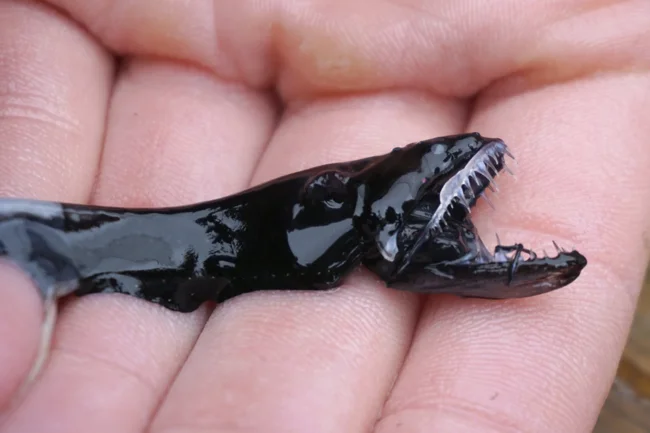
Let's leave politics aside and talk about a recently discovered tiny and scary fish. The scaleless blackfish entered the scientific record in 2015 when it was identified by a CSIRO research team off the Australian coast. A team of scientists led by Ian Suthers found the fish where they least expected it: near an underwater volcanic ridge where the water is considered too warm for such fish species. How the scaleless black fish has adapted to its unusual habitat does not necessarily make it an alien. But compared to other fish species, it is clearly one of a kind.
Glowing "ninja shark" 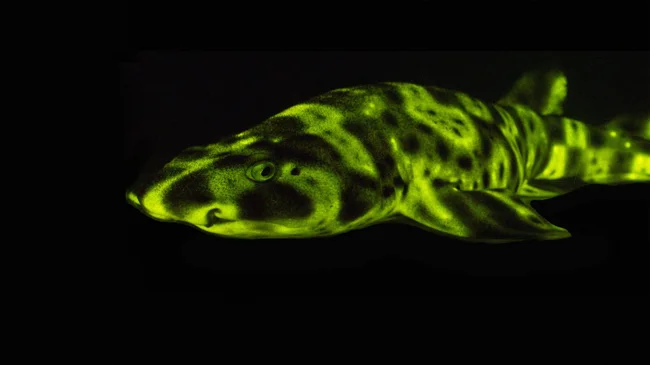
Another unique fish was discovered in 2015 and named after the novel Jaws, authored by Peter Benchley. The creature has black skin, large eyes and bioluminescent genes that allow it to partially glow in the dark. However, the Latin name is not a term with which most scientists are familiar. Vicky Vasquez, who helped discover the new species, consulted her eight-year-old cousins to find a more colloquial name for the creature. After looking at the pictures, the cousins thought the shark was a super ninja shark. A name that was changed to Glowing “Ninja Shark”. Like some other glowing sharks, the ninja shark can grow up to half a meter in length and lives off the coast of Central America. The unusual name is just one of the features that makes her stand out on the list.
Maratus Bubo 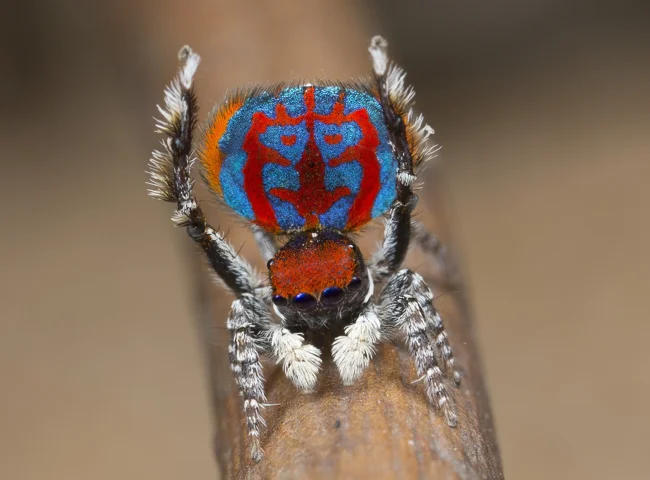
Let's return to land, to Australia, where another strange creature lives in the depths of the ecosystem. “Jumping Peacock Spiders” sound scary at first, but luckily they are quite small in size. Males grow up to 4.1 millimeters in length, while females reach 5.11 millimeters. And they've become a big sensation, ever since Jürgen Otto shared photos of males trying to win females with a spectacular mating dance in 2017. Otto originally discovered the species in 2005, but only recently have peacock spiders become better known.
Yeti Crab 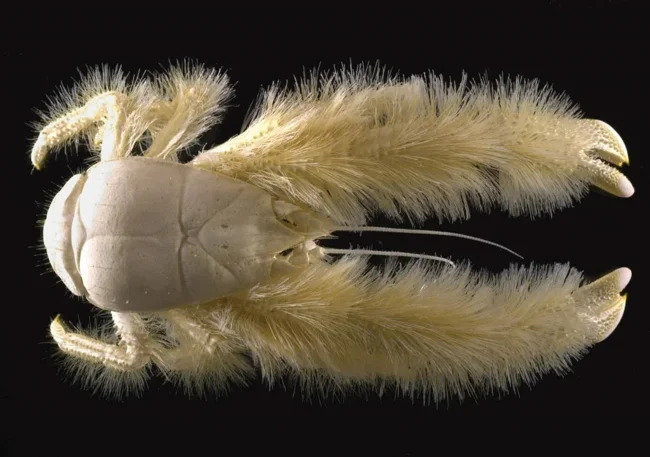
The Yeti Crab also became famous in 2005 when it was discovered by Robert Vrijenhoek and the rest of the crew of the research vessel Atlantis. During the process of evolution, this crab has developed an interesting biological feature to combat the cold: its forelimbs are completely covered with special bristles. The 15-centimeter crab needs its furry legs to stay warm in the waters of the South Pacific Ridge near Easter Island. The crab is completely blind and relies on bristles to navigate and protect itself from predators. There are such strange creatures!
Spider playing hide and seek 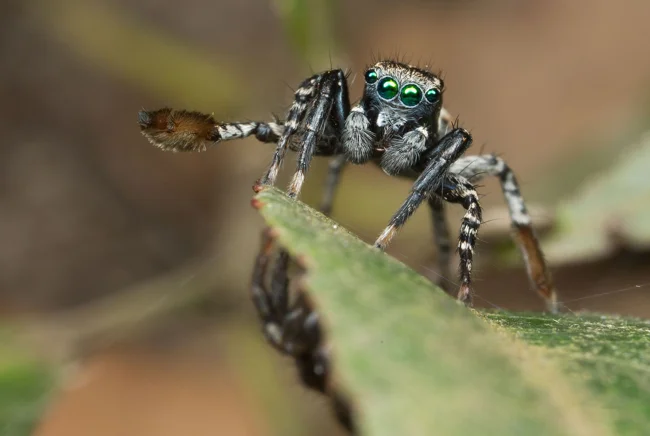
Jurgen Otto once again adds to the list of alien creatures by discovering another unique animal. In 2016, an Australian biologist published photographs of a spider playing “hide and seek” that he found in the Australian wilderness during a tourist trip. This spider also has a special mating dance: it waves its leg with a paddle-shaped thickening from a shelter and mates with those females who do not attack. From the outside it may seem that this is extremely risky behavior, but the opportunity to leave offspring is more important for spiders.
Synalpheus Pinkfloydi 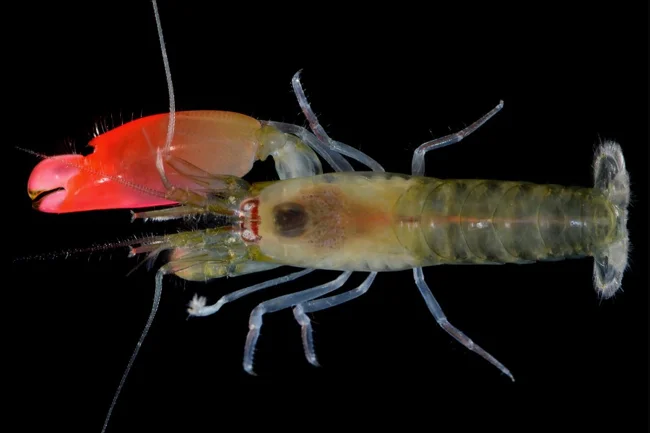
Now let's talk about a truly remarkable shrimp, named after an equally remarkable group. Discovered in 2017, the bright pink shrimp Synalpheus Pinkfloydi can kill with sound. When a shrimp claps its large claw, it produces sonic energy sufficient to stun or kill nearby prey. Arthur Anchor from the Federal University of Goiás in Brazil and his colleagues revealed themselves to be Pink Floyd fans when they discovered the shrimp. Remembering how the group was accused of killing all the fish in the lake near the concert site, they decided that such a name would suit it.
